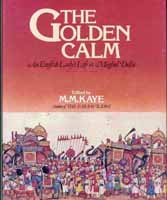Review of 'The Golden Calm'

AN EVOCATION OF THE MOGHUL EMPIRE
A rare evocation of the aura of a vanished world and way of life is found in a memoir of the latter days of the Moghul Empire. It is "The Golden Calm" An English Lady's Life in Moghul Delhi: Reminiscences of Emily, Lady Clive Bayley and by her father, Sir Thomas Metcalfe" edited by M M Kaye.
Miss Kaye, the wife of Maj-Gen Goff Hamilton, Ret. has a lifelong intimacy with India as is known to the hosts of readers of her bestselling novels, "The Far Pavilions" and "Shadow of the Moon". To call her the editor of "The Golden Calm" (to which I suspect she may have given the title) is understatement indeed. There is a rich interweaving of comment by her which illuminates Lady Emily's informal recollections in a far more engaging way than footnotes or other annotation could do. She becomes an integral part of the work, not only explaining much that otherwise would puzzle us but juxtaposing memories from her own childhood and youth that harmonize remarkably with those of the young women of several generations earlier. One cannot imagine this work without her guiding presence. She gives us a taste of what is to be expected from a full account of her own life which Miss Kaye has promised to write.
Still, the primary authors of the present volume are an attractive father and daughter. A gracious, informative Introduction is supplied by Lt.-Col. John Mildmay Ricketts M.C., great-great-grandson of Sir Thomas Metcalfe, who describes the amusing circumstances by which he discovered the existence of the "Delhie Book" and was given it by a spirited cigar-smoking great-aunt. He determined that it should no longer be "hidden away in a drawer."
Sir Thomas went to India in 1813. At the time of his death he was Delhi Resident, chief administrative officer of the East India Company. Of that role, the historian Sir John Kaye (ancestor of the editor) wrote: "The duties of the Delhi Resident were onerous and complex." He was at once a diplomatist and an administrator," a mere part of whose responsibilities was "To superintend the affairs of the pensioned Moghul and his family."
In the midst of his tasks, Sir Thomas set down reminiscences and descriptions of late moghul life in Delhi. He wrote flawless calligraphy characteristic of educated men of his time and commissioned for it paintings of scenes, buildings and persons to adorn its pages, by hands of many of Delhi's most gifted Indian artists. "The Delhie Book" is magnificently reproduced in facsimile in full colour, in segments interspersed with Lady Emily's narrative and Miss Kaye's glosses thereon.
In the quarter of a century before the long dominance of "John Company" was brutally ended by the Sepoy Mutiny in 1857 (see Miss Kaye's "Shadow of the Moon" for an evocation of it) there were wars and troubles enough on the subcontinent (an Afghan War and two Sikh Wars), in spite of which, Miss Kaye tells us, "the ancient Moghul capital of Delhi, together with its immediate surroundings, had enjoyed a halcyon period of calm that to its inhabitants, both Indian and British (not least among them the great Moghul himself, Bahadur Shah, last Emperor of Delhi and his friend the Resident...), must indeed have seemed golden." So it seemed, too, to Emily Metcalfe, who was born there, sent to England at age five for education, returned at 17, in 1848, and two years later married Sir Edward Clive Bayley.
She speaks of her reunion with her rather in 1848 - her mother having died while Emily was in England: "Both he and I cried with joy at being together again - but without her!... here I am, dictating this... on the 54th anniversary of that very day. The rush of memories is quite overwhelming, for all these scenes are as vivid as if they had happened yesterday."
From Sir Thomas's book there is a richly coloured, minutely detailed six-page foldout of a state procession of the King of Delhi which, surprisingly, "is in commemoration of the intended sacrifice of Abraham of his son Isaac." (That Muslim empire shared in the Old Testament traditions.)
The reminiscences end somewhat abruptly. Shortly thereafter an odd episode occurred. Emily was in Simla, in the hills, but was ill. Passage was booked for her return to England for her health. Then, she wrote in a letter, on the very night when she was to leave Simla, "we were startled by the birth of our first child!"
Miss Kaye observes: "Apparently it had never occurred to anyone that there might be a perfectly ordinary explanation for her 'illness' - least of all to Emily... Her own mother had been dead for many years, and possibly Aunt Mary jibbed at telling her young niece the facts of life. All the same, Edward must have been pretty dim not to have noticed anything odd, and he cannot have improved matters by fainting when the doctor told him of the event that had taken place."
Emily's memories are charmingly interesting but in my notes on the book I find myself dawn more to Miss Kaye's extended comments. Emily describes an exquisitely painful operation on her neck undergone in childhood. Miss Kaye remarks: "It reinforces my view that people as a whole were a good deal tougher in those days. Emily was only seven years old at the time, yet you will notice that she did not scream or struggle, but set her teeth and endured it."
As a reality of Anglo-Indian life, the many family separations "were one of the saddest aspects of the Raj: almost sadder than the terrible toil that heat and disease took yearly from the British who lived in India, and the fact that every mother expected to lose at least three children out of every five she bore... The wives of Indian-service officers and all British officials paid a heavier price for serving the Raj than anyone naowadays realises." A price for the golden days.
"The Golden Calm" is visually superb, charming, informative and highly unusual in its three interwoven texts. It contributes much to the lore of British India. by Edmund Fuller (22nd December 1980) in The Wall Street Journal
